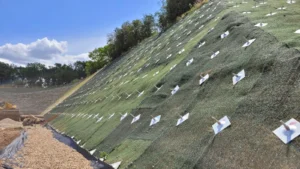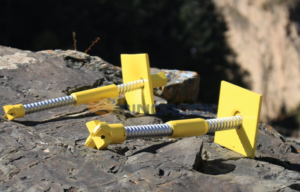In the modern construction industry, deep foundations are crucial for supporting structures where shallow foundations would not suffice. Deep foundations are typically defined as foundations that extend more than 5 meters below the surface, often into deep soil or rock layers. These types of foundations are generally required in complex construction environments, where the geological conditions are challenging or where heavy loads need to be supported. Selecting the appropriate construction techniques for deep foundation support is vital to ensuring the stability and safety of the structure.
Soil Nailing Wall Support
Soil nailing wall technology is one of the most commonly used methods for supporting deep foundations. It involves reinforcing the existing soil mass with soil nails, which are typically steel bars or tendons that are inserted into the soil at an angle to provide lateral support. The purpose of the soil nail wall is to stabilize the soil around an excavation or slope, preventing soil movement and collapse.
Conventional Construction Process
The traditional construction process for soil nailing walls includes several stages:
- Drilling (Manual or Mechanical): Holes are drilled into the soil or rock mass at specified intervals and depths.
- Installation of Soil Nails: Steel rods or tendons are inserted into the drilled holes to reinforce the soil. The nails are typically pre-stressed and act as tension elements to resist soil displacement.
- Grouting: A cement-based grout is pumped into the drilled holes to fill voids and ensure the soil nails bond securely with the surrounding soil.
- Binding of Steel Bars: Steel bars are used to bind the soil nails together, enhancing their load-carrying capacity.
- Sprayed Concrete: Once the nails are in place, a layer of sprayed concrete is applied to the surface to form a protective and cohesive barrier.
Advantages of Soil Nailing Wall Technology
- Low Cost and Easy Implementation: The soil nailing technique is relatively low-cost compared to other foundation support methods. It is also quick to implement, making it ideal for projects with tight schedules.
- Minimal Environmental Impact: Soil nailing walls are constructed with minimal disturbance to the surrounding environment, which makes them suitable for urban sites or sensitive ecological areas.
- Effective Stabilization: Soil nailing walls are highly effective at stabilizing slopes and preventing soil movement. This makes them ideal for areas with unstable ground or where excavation is required near existing structures.
The Role of Self-Drilling Anchor Bolts
Self-drilling anchor bolts have revolutionized soil nailing wall technology. Unlike traditional methods where drilling, grouting, and anchoring are performed separately, self-drilling anchor bolts combine these processes into one. This integration improves drilling efficiency and provides a superior anchoring effect. The self-drilling anchor bolt has become a staple in foundation-supporting engineering due to its ease of use, high performance, and cost-effectiveness.
Considerations in Soil Nailing Wall Construction
When using soil nailing walls, it is essential to consider factors such as drainage. Water accumulation behind the soil nail wall can lead to hydrostatic pressure, potentially compromising the wall’s effectiveness. Therefore, a proper drainage system is critical for maintaining the integrity of the wall. Additionally, the grouting procedure must be carefully controlled to ensure proper bonding between the soil and the reinforcement elements.
Slope Protection Pile Construction
Slope protection piles are another widely used method in deep foundation support construction. These piles are driven or drilled into the ground to create a barrier that prevents the displacement or collapse of a slope. Slope protection piles are often used in areas where slopes are unstable, such as in hilly or mountainous regions, or when constructing deep foundation pits in challenging soil conditions.
Conventional Construction Process
The process for slope protection pile construction involves the following steps:
- Site Preparation: The site is cleared of obstacles, and the position of the piles is marked.
- Setting the Position of the Pile Foundation: Accurate measurements are made to ensure the proper alignment of the piles.
- Burying the Casing: A casing is inserted into the ground to create a structure for the pile.
- Forming a Hole: A rotary drilling rig or manual excavation is used to form the hole for the pile.
- Placing the Reinforcement Steel Cage: A reinforcement steel cage is placed into the drilled hole to provide structural strength.
- Underwater Concreting: The hole is filled with concrete, often using an underwater concreting method to ensure that the pile is properly formed even in wet or submerged conditions.
Benefits of Slope Protection Pile Construction
- High Pile Formation Rate: One of the key advantages of slope protection pile construction is its ability to form piles quickly, which speeds up the overall construction process.
- Simple and Efficient: The construction process is straightforward, requiring relatively low levels of technical complexity, making it suitable for various construction projects.
- Preventing Displacement: Slope protection piles effectively prevent the displacement of the surrounding soil, particularly in deep foundation pit projects where the integrity of the surrounding ground is critical.
Quality Control and Construction Standards
The quality of slope protection piles is heavily dependent on the construction process, particularly the drilling and grouting stages. Adherence to strict construction standards is essential to ensure that the piles are properly formed and that the grout bonds effectively with the surrounding soil. A proper grouting process is crucial to ensure that the piles are strong enough to support the structure above.
Soil Anchor-Pile Support
Soil anchor-pile support technology involves the use of a drill rig to bore holes at predetermined positions, followed by grouting cement slurry into these holes. Once the grout has set and the soil has reached the required strength, twisted wire or other tensioning materials are inserted to create an anchor effect, ensuring that the soil around the pile is securely supported.
Conventional Construction Process
The construction process for soil anchor-pile support involves the following steps:
- Drilling: A drill rig is used to create holes at specific locations within the soil.
- Grouting: A cement slurry is pumped into the drilled holes to secure the piles and enhance their bonding with the surrounding soil.
- Tension Anchorage: Once the grout has hardened, twisted wire or other tensioning elements are inserted into the hole, anchoring the pile to the surrounding soil and providing lateral support.
Advantages of Soil Anchor-Pile Support
- Enhanced Safety and Stability: The soil anchor-pile method is particularly effective in ensuring the safety and stability of deep foundations, as it can withstand significant lateral forces.
- High Structural Strength: The anchor-pile system provides a high level of structural strength, making it suitable for high-rise buildings, bridges, and other large structures.
- Adaptability: Soil anchor-pile support can be used in various soil conditions, making it adaptable to different geological environments.
Considerations in Soil Anchor-Pile Construction
Before beginning construction, precise measurements must be taken to determine the exact location and depth of the drill holes. Accurate drilling is crucial to ensure that the anchor piles are placed in the correct position, preventing any deviation that could compromise the structural integrity of the support system. Additionally, obstacles in the soil should be cleared before drilling to avoid interference with the construction process.
Conclusion
The application of advanced construction technologies for deep foundation support has significantly improved the safety, efficiency, and effectiveness of construction projects. Technologies such as soil nailing walls, slope protection piles, and soil anchor-pile support systems are essential tools for ensuring the stability of deep foundations in complex geological environments. These methods not only enhance the structural integrity of buildings but also provide significant cost savings and time efficiencies compared to traditional techniques.
As the construction industry continues to evolve, the integration of new materials and technologies, such as self-drilling anchor bolts and advanced grouting techniques, will further optimize deep foundation support systems. By carefully selecting and applying these advanced techniques, engineers can successfully address the challenges posed by complex ground conditions, ensuring the long-term stability of structures built on deep foundations.





